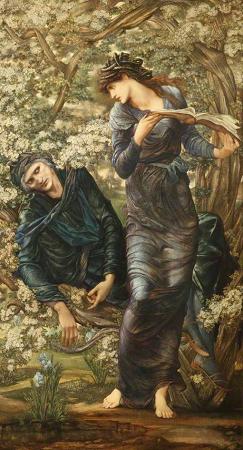Nimue. The Lady of the Lake is an enchantress in the Matter of Britain, the body of medieval literature and legend associated with King Arthur. She plays a pivotal role in many stories, including giving Arthur his sword Excalibur, enchanting Merlin, and raising Lancelot after the death of his father. At least two different sorceresses bearing the title the Lady of the Lake appear as separate characters in some versions and adaptations since the Post-Vulgate Cycle and consequently Le Morte d'Arthur. Although today the Lady of the Lake is best known as Nimue, Vivian, and Vivien, different medieval authors and copyists have also given the character various names, including Nimane, Nimanne / Niv en e / Vivienne, Nimian e, Nymenche, Nin eve, Niniane, Niviana, and Ui ane, among other variations, including alternate spellings with the letter i written as y. The most primitive French form might be Niniane. The name Nimue, in which the letter e can be written as ë or č, has been popularized by Thomas Malory's Le Morte d'Arthur and itself has several variations: in William Caxton's edition, her name appears as Nymue, Nyneue and Nynyue, but it had been rather Nynyve and Nenyve in Malory's original Winchester Manuscript. Even though Nymue, with the m, appears only in the Caxton text, Nimue is perhaps the most common name of the character as this was the only version of Le Morte d'Arthur published until 1947. Arthurian scholar A. O. H. Jarman, following suggestions first made by scholars of the 19th century, proposed that the name Viviane used in French Arthurian romances were ultimately derived from the Welsh word chwyfleian, meaning a wanderer of pallid countenance, which was originally applied as an epithet to the famous prophetic wild man figure of Myrddin Wyllt in medieval Welsh poetry. Due to the relative obscurity of the word, it was misunderstood as fair wanton maiden and taken to be the name of Myrddin's female captor. Others have linked the name Nymenche with the Irish mythology's figure Niamh, or connected the name Niniane with the Welsh mythology's figure Rhiannon or the 5th-century saint Ninian. Chrétien de Troyes's Lancelot, the Knight of the Cart, the first known story featuring Lancelot as a prominent character, was also the first to mention his upbringing by a fairy in a lake. If to accept that the German Lanzelet by Ulrich von Zatzikhoven contains elements of a more primitive version of this tale than Chrétien's, the infant Lancelot was spirited away to a lake by a water fairy known as the Lady of the Sea and then raised in her Land of Maidens. The fairy queen character and her paradise island in Lanzelet are reminiscent of Morgen of the Island of Avallon in Geoffrey of Monmouth's Vita Merlini. Guendoloena and Ganieda, respectively Merlin's one-time wife and his sister from Geoffrey's work, as well as the Roman goddess of the hunt and the nature, Diana, can also be considered prototypes. The Lady of the Lake began appearing in the French chivalric romances by the early 13th century, becoming Lancelot's fairy godmother-like foster mother. In the Lancelot-Grail prose cycle, in which she is known for her connection to the color white, the Lady resides in an enchanted realm disguised as an illusion of a lake. There, she raises the child Lancelot after the death of his father King Ban, as well as his also orphaned cousins Lionel and Bors after having her damsel Seraide rescue them from King Claudas. She then aids Lancelot in various ways during his early adventures, including with her magic item gifts and through her maidens serving as her agents and messengers, and restoring him to sanity on multiple occasions.
more...




